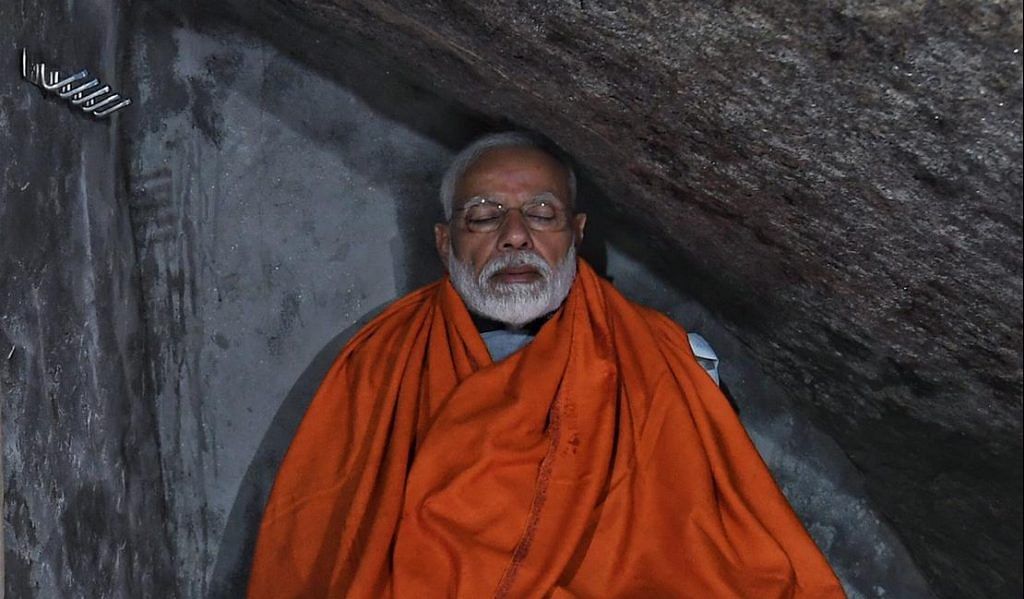Sunday’s exit polls, which gave the election to the BJP, coincided with Prime Minister Narendra Modi’s visit to the Kedarnath-Badrinath shrines. In Kedarnath, the PM meditated inside a cave in a saffron shawl and was elsewhere photographed in a tiger print blanket that Shiva, the temple deity, is believed to wear as he strides across the heavens.
Modi’s ability to surprise these past five years has been accompanied by his immense capacity for exhibitionism. Pervez Musharraf, the former Pakistani president, comes to mind; during his trip to Agra in 2001, Musharraf changed his clothes five times in the space of 24 hours.
Of course, Indira Gandhi and her son, Rajiv, also liked wearing the clothes and headgear of the places they visited in the far-flung corners of India; they saw themselves as identifying with those places and people and thereby becoming larger than their individual selves.
Also read: The traditional BJP voter is upper caste, upper class & a staunch believer in Hindu pride
Certainly, Modi is unique because his sartorial attention to detail is reflected in his politics. Much of his clothing markers are coloured saffron; the shawl he wrapped around himself in the Kedarnath cave as well as the sash with his flowing robes as he walked on a path that cut through the accumulated snow were both a startling orange. He is at once India’s Prime Minister and a Hindu pilgrim.
The Kedarnath messaging is astute, even if it’s crude. The saffron indicated that in this 2019 election, the mask had been dropped. Unlike the 2014 polls, where the emphasis was on ‘vikas’ and ‘acche din’, progress and development, the 2019 campaign made no attempt at hiding the fact that the BJP is a Hindu party, seeking the votes of Hindus.
If the exit polls are to be believed, Modi’s win indicates the successful marginalisation of Muslims. They can continue to be relegated to ghettos and expected to go about their lives, as they do in large parts of Gujarat.
But a large part of Modi’s success is due to his constant communication with his voters. He tells them what they want to hear. “I never ask for anything… I thank the Election Commission for giving me two days’ rest,” Modi told reporters in the shadow of the Kedarnath shrine. Although temple priests Pravin Tiwari and Omkar Shukla said they had performed the ‘rudrabhishek’ prayers for Modi, a puja which is “done for victory”.
Certainly, several millions who seem to have voted the BJP back to power would agree. It has been a long and gruelling campaign and the visit to Kedarnath is a thanksgiving gesture. After all, most people had no idea who their local candidates were – they voted for Modi. They see nothing wrong in him making the trek to Kedarnath in an IAF chopper – prime ministers are allowed small concessions.
Also read: TMC complains to Election Commission about PM Modi’s ‘unethical’ media address at Kedarnath
The amalgam of politics and religion is as old as time. Even Mahatma Gandhi famously told Jawaharlal Nehru that separating Church from State as is the norm in the West is simply not possible in India. The argument that the Partition of India should not have taken place on the basis of religion still continues.
Some of the discomfort over Modi’s public pursuit of religious activity stems from his driving need for exhibitionism. Who meditates in the public glare of cameras? But Modi is a unique political phenomenon because he seems to have convinced the people that he is the answer not only to their daily needs, but will also take care of the nation’s interests.
Much has already been written about the many government schemes – the LPG cylinder scheme called ‘Ujjwala’, toilets in every home – that were leveraged to identify Modi with their beneficiaries, potential voters across the length and breadth of India. As well as the invocation of the Balakot strikes, signalling a determination to protect India and the people who live in the country, at any cost.
But if Modi, indeed, returns to power as he is widely expected to, the single-most important reason for his second term will be the fact that the Opposition simply failed to put up a united front.
Even the regional experiment – where political parties were supposed to have protected their bastions – hasn’t held up as well as it should have. Opposition-ruled Madhya Pradesh, Karnataka and Rajasthan, with their slim majorities, are already looking shaky as the BJP begins to apply pressure on unsure MLAs.
Also read: Pracharak Modi: The mask you see, is the man you get
Congress MLAs in Rajasthan especially are already beginning to grumble about the fact that out of 136 public meetings, chief minister Ashok Gehlot held as many as 93 in Jodhpur, the constituency from where his son fought the election.
Fresh from his pilgrimages to Kedarnath and Badrinath, even as the general election is done and dusted, Modi seems determined to establish the BJP rule at least in those three states. His ambition knows no rest and no bounds.
